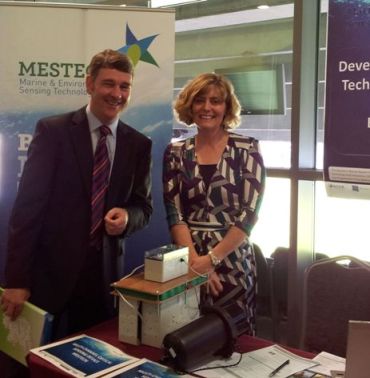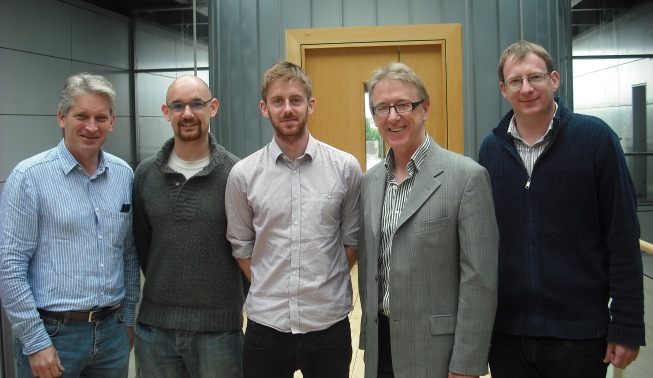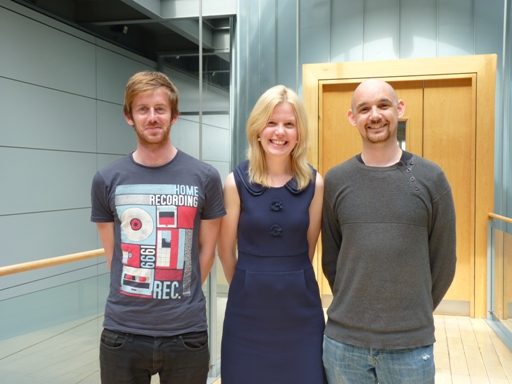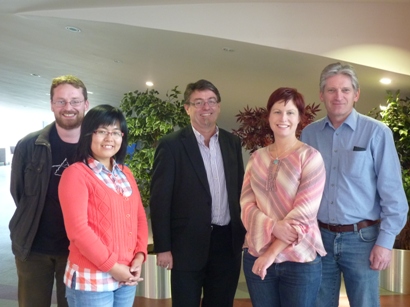Chemical Sciences - Adaptive Sensors Group - News Archive
Adaptive Sensors Group
News Archive
Commericalisation Awards 2011 - 5th December 2011
Innovation Dublin event - 8th November 2011
NCSR Seminar - 3rd November 2011
Flann O'Brien celebrated by Prof. Dermot Diamond
NCSR Seminar - 2nd November 2011
CLARITY at "Silicon Valley comes to Ireland Event"
MicroTas 2011
Prof. David Officer Seminar - 27th September 2011
ASG researchers at Marie Curie Researchers symposium 2011
AGS at Environment Ireland Conference
Prof. Doug MacFarlane Seminar - 29th August 2011
Sensor Devices 2011: 21-27th August 2011
ASG at SPIE Optics and Photonics 2011
Dr. Ekaterina Izorgodina Seminar - July 2011
COIL-4 in Washington
Dr. Fabio Di Francesco Seminar - 10th June 2011
ASG Student in Research Exchange
Prof. Gordon Wallace Seminar - 20th April 2011
WANDA in OZ
ASG Members Present their Research - Feb/March 2011
MASK Group First Meeting - February 2011
CLARITY PI gives opening lecture at Micro-TAS 2010
Lab-on-a-Chip European Congress, Dublin 2010 >
A Survey of Water Quality in the Dublin Area
CLARITY Researcher in the News
Ground Breaking Research
Researcher Wins DCU Fellowship
Clarity Feature in Nano Magazine
Short-Term Travel Fellowship Awarded to Dr. Robert Byrne
Best Poster at The Fourth EST International Conference 2008
CLARITY Website Announced - April 2008
IBM Visit
Graduation 2007
Polymers Down Under - September 2007
Wearables Make the Headlines
ASG Reseacher Wins DCU Research Fellowship
AIC in France - August 2007
ASG Paper One of the Most Downloaded
Smart Packaging Provides Seafood Quality, Safety Traceability - 2007
Group Member Wins Colin Barnes Award - Dec 2006
Two ASG Members Graduate with PhDs at DCU Autumn Conferring 2006
Adaptive Sensors Group receives Australian Research Council Award
Wearables Meet Visual Theatre
A Flash of Brilliance
Energy & Materials Workshop
Awards 2006
ASG Researcher Wins Best Presentation at ICFIA 2005
Commercialisation Awards 2011 - 5th December 2011
On Monday 5th December, Invent DCU marked 10 years of commercialisation activity with a gala event in The Helix. The event highlighted DCU's impressive commercialisation achievements and gave an overview of Invent's activities over the last decade.
DCU President Prof. Brian MacCraith welcomed the large gathering from industry, research and academia. Many state agencies and supporters of Invent were also represented including SFI, Enterprise Ireland and AIB.
Prof. MacCraith acknowledged that Invent plays a pivotal role in assisting DCU to be a research-intensive, globally-engaged University of Enterprise that focuses on the discovery of knowledge and its translation into societal and economic benefit. He views Invent as the interface between DCU's research community and industry and is the engine that catalyses and drives innovation at DCU.
Invent CEO, Richard Stokes then highlighted the organisation's achievements over the past 10 years. He confirmed that since its formation in September 2001, Invent DCU is now one of the leading Technology Transfer Offices in Ireland in terms of licencing activities to both Irish companies and to overseas markets. In 2011 alone, Invent assisted in the establishment of 6 new start-up companies based on DCU technologies.
A poster display of Technologies which were licensed to Irish and overseas companies were profiled along with the 6 new technology start up companies from 2011.The event came to a close with the Annual Commercialisation Awards Ceremony.
These awards are granted for commercialisation through licences, spin-outs or innovation partnerships with fully negotiated licence terms in the areas of Industrial Technologies, Life Sciences and Health and Information and Communication Technologies (ITC).
Huge congratulations to all ASG the winners, Prof. Dermot Diamond, Mr. Vincenzo Fabio Curto, Dr. Fernando Benito-Lopez, Dr. Robert Byrne, Dr. Damien Connolly, Dr. John Cleary and Dr. Damien Maher. For more information see www. dcu.ie/invent.
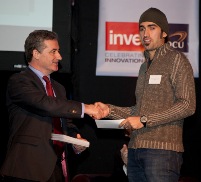
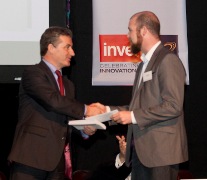
(left) Vincenzo Fabio Curto receiving his award from Richard Stokes, CEO Invent, right, Dr. John Cleary receiving his award
Innovation Dublin event - How to Monitor your own health and wellbeing – 8th November
As part of Innovation Dublin 2011, the National Centre for Sensor Research, in association with the Invent Centre, held a showcase of the latest innovative developments in diagnostic and sensor technology surrounding the healthcare industry. The event entitled, "Empowering people to monitor their own health and wellbeing" demonstrated the latest technological advancements and products being developed for use in the management of human health in the home or point of care setting.
Presentations were given by Dr. Shirley Coyle from ASG, Fergus Fleming from the Biomedical Diagnostic Institute (BDI) as well as from representatives from BioSensia and Crescent Diagnostics, two Irish companies. A poster session and demonstrations of technology developed by ASG and the BDI followed the presentations. Congratulations to all involved in the event.
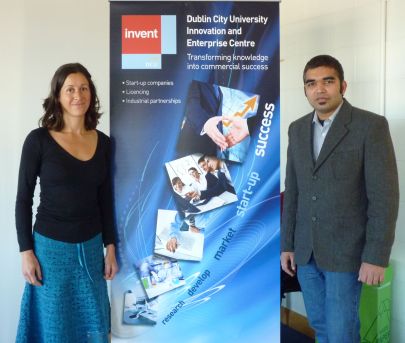
Dr. Shirley Coyle, CLARITY and Mayank Saraswat (CBAS) who presented a poster at the event
NCSR Seminar - 3rd November 2011
On the 3rd November, Prof. George Malliaras, head of the Department of Bioelectronics, Centre Microelectronique de Provence, Ecole Nationale Superieure des Mines de Saint Etienne, France, presented a seminar entitled, "Organic Electronics at the Interface with Life Sciences.
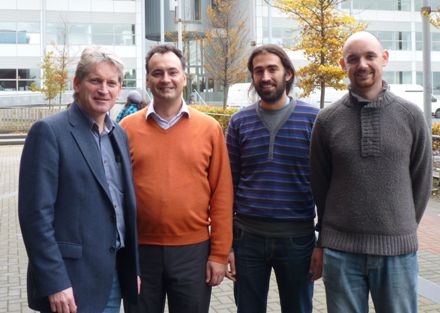
(L-R) Prof. Dermot Diamond, Prof. Geroge Malliaras, Vincenzo Curto and Dr. Kevin Fraser
Flann O'Brien celebrated by Professor Dermot Diamond – 16th October 2011
Many fans of Flann O'Brien gathered together in Trinity College on Sunday 16th October for the final day of Flann 100, a centenary celebration of the Dublin writer Brian O'Nolan .One of the highlights of the event was our very own NCSR Director Professor Dermot Diamond, who gave a science lecture where he convincingly argued that O'Brien was not just a literary genius but a scientific prophet. Professor Diamond set recent experiments in the fields of thermodynamics, quaternion theory and atomic theory against excerpts from O'Brien's books, suggesting that O'Brien anticipated some of the greatest scientific discoveries of the 20th century.
The event was featured in Irish Times on Monday 17th October.
NCSR Seminar - 2nd November 2011
On 2nd November 2011, Prof. Hiroshi Ishida from the department of Mechanical Systems Engineering, Tokyo University of Agriculture and Technology presented a seminar entitled "Active Flow Generation to Manipulate Chemical Signal Reception".
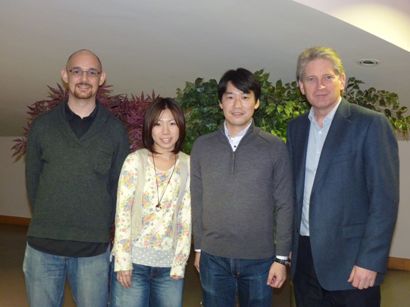
(L-R) Dr. Kevin Fraser, one of Prof. Ishida's students, Prof. Hiroshi Ishida and Prof. Dermot Diamond
CLARITY at "Silicon Valley comes to Ireland Event"- 6th October 2011
DCU recently welcomed a delegation of Irish American Technology Leaders and Investors from Silicon Valley, California. The group met with 40 selected Irish technology companies in a series of private investor workshops at Invent, the University's Innovation & Enterprise Centre. Ten of these companies will be chosen to be showcased at the Annual ITLG - Irish Times Innovation Awards event at Stanford University to be held in Spring 2012.
ASG's presence at this event was pictured in silicon republic.com on Friday 7th October. Pictured below are Minister for Jobs, Enterprise and Innovation, Richard Bruton TD (far right); John Hartnett, president and founder, ITLG (left), speaking with Damien Maher of ASG and CLARITY. Over 400 people attended the ITLG Silicon Valley Comes to Ireland event held at DCU, which was opened by the Minister for Jobs, Enterprise & Innovation Richard Bruton TD.
![]()
MicroTas 2011 - 2nd - 6th October 2011
ASG researchers presented at the 15th International Conference on Miniaturized Systems for Chemistry and Life Sciences (MicroTas 2011) which ran from October 2-6 in Seattle. Monika Czugula was awarded a student travel grant of $500 to attend the conference. She was also invited to give a presentation entitled "Novel Optical Sensing System Based on Wireless Paired Emitter Dectector Device for Lab on a Disc Water Quality Analysis". Larisa Florea presented a poster entitled "Dynamic ph Sensing in Micro-fluidic Devices Using Adaptive Coatings Based on Polyanaline". Vincenzo Curto also presented a poster entitled "Wearable Micro-Fluidic pH Sweat Sensing Device Based on Colorimetric Imaging Techniques"
MicroTAS 2011 continued a series of Conferences that are the premier forum for reporting research results in microfluidics, microfabrication, nanotechnology, integration, materials and surfaces, analysis and synthesis, and detection technologies for life science and chemistry.
More information about this international conference can be found at www.microtas2011.org. MicroTAS 2012 will be held in Okinawa, Japan from the 28th October to the 1st November.
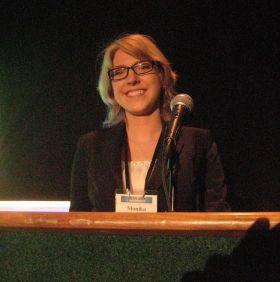
Monika Czugula presenting at MicroTas 2011
Prof. David Officer Seminar - 27th September 2011
Prof. David Officer from the ARC Centre of Excellence for Electromaterials Science presented a seminar entitled "Developing Multifunctional Electromaterials for Energy-related Applications" on Tuesday 27th September. In his seminar, he presented the progress the ARC Centre have made in designing and using single and multiple porphyrins, nanostructured carbons and functionalised conducting polymers in energy-related applications.
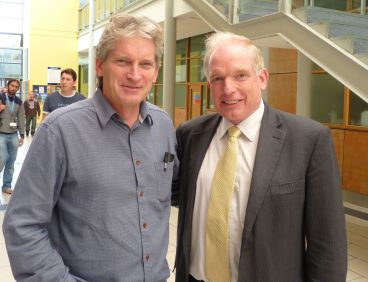
Prof. Dermot Diamond (left) with Prof. David Officer
ASG researchers at the Marie Curie Researchers symposium in Warsaw – 24th – 27th September 2011
Three ASG researchers presented posters at the "cience Passion Mission Responsibilities Marie Curie Researchers Symposium in Warsaw from 24-27th September.
Kevin Fraser presented Ionic Liquids for Enzymatic Sensing, Bartosz Ziolkowski presented Next Generation Autonomous Analytical Platforms for Remote Environmental Monitoring and Monika Czugala presented Next Generation Autonomous Analytical Platforms for Remote Environmental Monitoring: Generation of fully functioning biomimetic analytical platforms for Water Quality. This symposium organised within the Polish Presidency of the EU Council gathered about 350 participants, including 280 Marie Curie fellows from 47 countries.
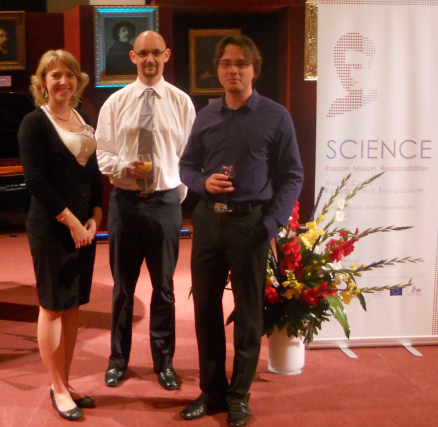 Pictured above are Monika, Kevin and Bartosz at the reception event.
Pictured above are Monika, Kevin and Bartosz at the reception event.
ASG at Environment Ireland Conference – 15th September 2011
The 7th Annual Environment Ireland conference took place in Croke Park on 15th September. Members of the Adaptive Sensor Group manned exhibition stands at the event. Edward McDonnell from CLARITY presented the water monitoring system developed by researchers in the Adaptive Sensors Group. Lorna Fitzsimons from the ASG and the Marine and Environmental Sensing Technology Hub (MESTECH) showcased the deployment platforms being currently being developed by MESTECH.
Environment Ireland is Ireland's largest conference on environmental policy and management. The conference is organised in association with the Environmental Protection Agency (EPA) and the Department of Environment, Community and Local Government. The conference is attended each year by delegates representing all the main sectors with an interest in Ireland's environment, including many from Great Britain and Northern Ireland.
Environment Ireland provides an important opportunity for all the key players in the environment sector to come together for networking and discussion. Away from the formal conference sessions, there is ample opportunity for delegates to meet and do business in the margins of the conference, particularly in the lively exhibition area and during the many networking breaks scheduled throughout the conference programme.
Dr. Peter Heffernan, Marine Institute with Dr. Lorna Fitzsimons, MESTECH
Prof. Doug MacFarlane Seminar - 29th August 2011
Professor Douglas R. MacFarlane from the Australian Centre for Electromaterials Science at Monash University gave a presentation entitled "Ionic Liquids: Applications in the Electro- and Bio- Sciences" to the NCSR and School of Chemical Sciences on 29th August. Professor Doug MacFarlane leads the Monash Ionic Liquids Group at Monash University. He is also the program leader of the Energy Program in the Australian Centre for Electromaterials Science. His group, numbering around 20 research staff and students focuses on a range of aspects of ionic liquids and their applications, especially in Sustainable Energy applications.
(R-L): Professor Dermot Diamond, Dr Kevin Fraser, Simon Gallagher (all NCSR), Professor Doug MacFarlane (Australian Centre for Electromaterials Science at Monash University) and Dr Nick Gathergood (School of Chemical Sciences, DCU).
Sensor Devices 2011 – 21-27th August 2011
Congratulations to Prof. Dermot Diamond whose paper "Distributed Chemical Sensor Networks for Environmental Sensing" was one of a small number of 'best papers' in particular categories selected by the organising committee of the Sensor Devices 2011 conference held in Nice, France in August. In addition to receiving the award, Prof. Diamond was invited to submit an extended version of the paper the Sensors and Transducers Journal.
ASG at SPIE Optics and Photonics 2011 – 21st – 25th August 2011
Dr Kevin Fraser and Dr Fernando Benito Lopez, CLARITY postdocs at DCU, both presented their work at SPIE Optics and Photonics 2011 in San Diego, which ran from August 21-25th. Kevin gave an invited talk entitled "Wearable Electrochemical Sensors for Sports Athletes" and presented a poster entitled "Electrochemical transistors with ionic liquids". Fernando gave a talk on "Materials science: the key to breakthroughs in micro-fluidic devices". The photo above shows Fernando and Kevin at the conference.
Kevin recently gave a guest lecture at Berkley University entitled "Wearable electrochemical sensors for monitoring performance athletes"
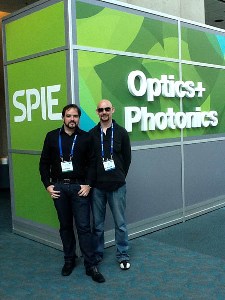
Dr. Fernando Benito-Lopez and Dr. Kevin Fraser at the SPIE Optics and Photonics Conference
Dr. Ekaterina Izorgodina Seminar - July 2011
On 28th July when Dr. Ekaterina Izorgodina from the University of Muenster presented a seminar entitled Unique properties of Ionic Liquids: What can an initio theory do? During her talk, Dr. Izgorodina presented her groups efforts in applying high-level quantum chemical methods to bring fundamental insight into unique properties of ionic liquids.
(L-R) Simon Gallagher, Dr. Ekaterina Izgorodina and Dr. Kevin Fraser
COIL-4 in Washington - 15th - 18th June 2011
ASG researchers from Professor Dermot Diamond's group are presenting at the 4th International Congress on Ionic Liquids (COIL-4) in Washington, DC from June 15-18, 2011 to explore the fascinating world of the science and application of ionic liquids. This meeting is the 4th in a series of successful meetings dating back to June 2005 when over 450 participants from 33 countries met in Salzburg, Austria to discuss and debate the lively topic of ionic liquids. Equally successful meetings have subsequently been held in Yokohama (COIL-2, 2007), and Cairns, Australia (COIL-3, 2009).
Ionic Liquids are not new materials - they have been known for over 100 years, but have gained a substantial growth in renewed interest over the last 20 years. Dr Kevin Fraser, Dr Fernando Benito- Lopez, Andrew Kavanagh, Simon Gallagher and Vincenzo Curto are the ASG researchers who are presenting. For more information on the conference go to the conference website- http://coil-4.org/.
Dr. Fabio Di Francesco Seminar - 10th June 2011
Dr. Fabio Di Francesco from the University of Pisa on the 10th June. The talk, entitled Playing with science under the tower, examined the identification of chemical markers in easily obtainable fluids such as sweat and saliva.
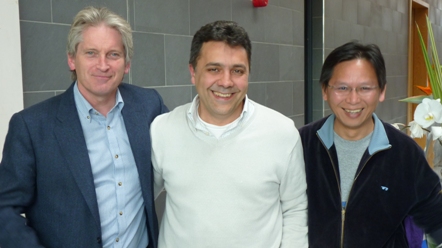
(L-R) Prof Dermot Diamond, Dr. Fabio Di Francesco and Dr. Kim Lau
ASG Student in Research Exchange - June 2011
Bartosz Ziółkowski a Marie Curie PhD student working in Clarity has recently successfully applied for funding from the German Research Foundation for a research exchange visit at professor Andreas Taubert’s laboratory at the University of Potsdam. This new collaboration aims at developing new stimulus responsive materials to be used in new low power, smart, autonomous sensor platforms produced at Clarity labs. With initiatives like this we can improve out sensor technologies getting one step closer to the visionary wireless, autonomous smart sensing devices. But also develop a Europe wide network of expertise in interdisciplinary research. Such networking is increasingly important for creating and securing current FP7 and upcoming FP8 calls.
DFG (Deutsche Forschungsgemeinschaft) is a self governing German Research Foundation that provides funding for research in all fields of science and humanities. Funding is available for individual researchers as well as for institutions and research infrastructure. One of DFG objectives is to support and intensify research exchange between German institutions and those based in other countries. Thanks to the initiative of dr Robert Byrne (Dublin City University) and professor Andreas Taubert (Potsdam University) Bartosz Ziółkowski can create a new link between Clarity and Potsdam University.
Prof. Gordon Wallace Seminar - 20th April 2011
Prof. Gordon Wallace from the ARC Centre of Excellence for Electromaterials Science (ACES), Intelligent Polymer Research Institute (IPRI), University of Wollongong, Australia, presented a seminar entitled Organic Bionics – Nanodimensional Cues for Nerve Cell Growth in the NCSR on 20th April.
During his talk, Prof. Wallace addressed how the effective interfacing of biology and electronics is changing, how we think about medical science. The range of conducting materials available has been greatly expanded in recent years since the discovery of conducting polymers and the development of protocols for producing nanostructured carbons.
During his lecture, Prof. Wallace presented his most recent findings around interfacing with nerve and muscle cells. He also discussed the use of conducting polymers as a platform to support and stimulate nerve growth which has proven highly effective. The use of nanodimensional fibers as topographical cues was also be addressed.
Recent studies at IPRI demonstrate that this compatibility is dependent on the inherent nanostructure of ICP surfaces. These, along with the many challenges and opportunities that remain in this area of research were also discussed.
(L-R) Dr. Karl Crowley (DCU), Ms. Bo Weng (IPRI), Prof. Gordon Wallace (IPRI), Dr. Aoife Morrin (DCU) and Prof. Dermot Diamond (DCU)
WANDA in OZ
Cormac Fay, a PhD student in ASG DCU, recently came back from a research visit to the University of Wollongong, Australia. While Cormac was there, he became involved in a number of projects in addition to maintaining many other projects in DCU remotely. Of noteworthy interest was the progression of the WANDA project (a robotic fish platform capable of patrolling a water body and reporting chemical composition levels wirelessly to a base station via an onboard
camera).Not only does this project reflect ASG's international collaboration regime, it is also applicable across a number of CLARITY's Research Streams (RS) and involves internal elements from the National Centre for Sensor Research (NCSR).
This, in conjunction with advanced polymers i.e. Poly Pyrrole (PPy) actuators (a tri-layer planar material that can bend about its own axis once an electrical stimulus is applied, and bend the opposite direction when the polarity is reversed) from the IPRI fulfils WANDA's movement capability resulting in a fish like movement. As a result of the extensive capabilities across
ASG, CLARITY, the NCSR and the IPRI, the project was capable of beingpushed forward from the work reported in its first publication i.e. the proof of concept phase. Specifically, the design and realisation of an unnaturally shaped and chromo
coloured sensor stations were accomplished through the use of the IPRI's fabrication facilities. These stations were then
equipped with advanced colorimetric chemical sensing polymer gels made in DCU within the NCSR.Following this, onboard electronics allowed for wireless, real-time control of the actuators (and therefore fish movement) via a complementary
control program executing on a nearby laptop.
Also encased within the fish body was a wireless colour camera that also communicated to the laptop Once the video stream was received, feedback signals were sent to the fish via the control program and thus resulted in autonomous movement through what advanced image recognition and object classification control algorithms. During a patrol, WANDA is able to classify pixels that represent a sensor station based on its unique shape and colour though the use of Support Vector Machines (SVMs).Furthermore, WANDA is able to interpret how far away a station is even with monocular vision. Once located, she extracts the colorimetric chemical indicator gels and is able to determine the local chemical state via its colour.
Recent Presentations -Feb/March 2011
ASG members have had a busy couple of months presenting their research across the globe. Here are the details of some recent talks:
‘Remote Sensing and the Aging Population – Emerging Opportunities and Associated Pitfalls’, invited lecture, presented at ‘Advanced Technologies for an Ageing Population’ Institute of Nanotechnology, The IET Teacher Building, St. Enoch Square, Glasgow, 24 March 2011.
Enhancing Quality of Life and Assisting Independent Living using Sensor Networks, invited oral presentation at the Collaborative Research Opportunities Workshop ‘Enabling Technologies for Active Ageing’, AIIM/IPRI, Innovation Campus, University of Wollongong, 14th February 2011. This presentation was featured on the University TV channel regional TV (WIN 6-7 local news).
Fernando Benito-Lopez, Robert Byrne, Shirley Coyle, Dermot Diamond, Ionogel Materials for Fluid Control and Sensing in Microfluidic Devices, Centro Nacional de Microelectronica (CNM), Universidad Autonoma de Barcelona, 10th February 2011, Barcelona, Spain. (Invited Seminar).
‘Stimuli-Responsive Materials – Their Role in the Realisation of Next Generation Autonomous Sensing Devices’, invited lecture presented at 2011 ACES Symposium on Electroactive Materials, Intelligent Polymer Research Institute, Innovation Campus, University of Wollongong, 9th February 2011.
MASK Group First Meeting - February 2011
The first meeting of the MASK group (Australia) took place in February 2011 to discuss the programme of exchanges that will occur under the new MASK FP7 Marie Curie/Australian Academy of Science agreement.

(L-R) Prof. Doug MacFarlane (Monash), Prof. David Officer (IPRI UOW), Prof. Gordon Wallace (IPRI, UOW), Dr. Jenny Pringle (Monash), Dr. Trevor Lewis (UTAS), Rochelle Warren (UOW Research Development Officer), Prof. Dermot Diamond (DCU), Dr. Pavel Nesterenko (UTAS)
CLARITY PI Gives Opening Lecture at Micro-TAS 2010
Professor Dermot Diamond, a DCU based CLARITY Principal Investigator gave the opening invited lecture at the international conference Micro-TAS 2010, in Groningen in the Netherlands.
His plenary lecture was titled From Evolution to Revolution in Water Quality Monitering: Are Stimulus-Responsive Materials the Key to the Analytical Platforms of the Future?
The conference had 1000 registered delegates and was formally opened by the Crown Prince of the Netherlands, and was covered in the press and television.
The picture below, taken by Jan Taco te Gussinklo (jan.taco.te.gussinklo@home.nl) features Prof. Dermot Diamond, CLARITY, Prof. Jaap den Toonder, Philips Applied Technologies, Eindhoven University of Technology, The Prince of Orange, Prof. Elisabeth Verpoorte, University of Groningen,Prof. Albert van den Berg, Director, MESA+ Institute, University of Twente.
More information about the conference can be found here.
Lab-on-a-Chip European Congress, Dublin 2010
On 25 and 26 May 2010, the fourth Lab-on-a-Chip European Congress took place in Dublin, Ireland. Amongst the speakers were Prof. Dermot Diamond and Fernando Benito-Lopez. The attached article reviews some key presentations as well as the overall trends observed in the field of microfluidics as presented in this conference. To view article, please click here.
A Survey of the Microbiological Water Quality of Costal and Fresh Waters in the Dublin Area
Dr. Yuliya Shakalisava, Ms.Christina Doherty and Mr. Wojciech Hahnel carried out a microbiological survey of river, canal and costal waters in the Dublin area and uncovered some shocking results.
A full report on this research can be found here .
CLARITY Researcher in the News
CLARITY researcher Dr Fernando Benito Lopez and colleague’s work on sweat sensors was featured in last week’s Sunday Times & New Scientist.
Scanned Times article can be found here . New Scientist article can be found here .
Ground-Breaking Research
Great work published in special issue on Ionic Liquids in Physical Chemistry Chemical Physics. Link below:
http://www.rsc.org/Publishing/Journals/CP/article.asp?doi=b920580b
Researcher wins DCU Fellowship
Dr. Aleksander Radu has received a DCU Fellowship for a project entitled "Potentiometric system for detection of drugs of abuse using quantum dot-modified aptamers". The project will be executed in collaboration with Dr. Arben Merkoci from Catalan Institute of Nanotechnology, Barcelona, Spain.
Clarity Feature in Nano Magazine
Dr. Shirley Coyle and Prof. Dermot Diamond are featured in the magazine Nano . Their article is entitled Nanosensors: Big benefit or big brother .
Short-Term Travel Fellowship Awarded to Dr. Robert Byrne
Dr. Robert Byrne a post-doctoral fellow in Prof. Dermot Diamond’s Adaptive Sensors Group has been awarded a Short Term Travel Fellowship (STTF) from Science Foundation Ireland (SFI). The STTF supplement is designed to enable team members in an SFI funded group to collaborate on research projects in laboratories outside the Republic of Ireland. This award in conjunction with Prof. David Officer, will allow Robert to travel to the Intelligent Polymer Research Institute, University of Wollongong, Australia. Robert plans to spend two months working with Prof. Officer’s research team on the synthesis and characterization of photochromic polythiophenes. Photochromic switches are an intriguing class of organic molecules which allow the control of molecular structure and function with light. This offers the possibility of effecting dramatic changes to the bulk properties of a system by photonic irradiation. It is hoped that this research visit will help to strengthen research collaboration between the two groups.
Best Poster at The Fourth International Conference on Environmental Science and Technology 2008
A poster entitled Using Autonomous Sensing Devices For Environmental Monitoring was awared the best poster at the Fourth International Conference on Environmental Science and Technology, 2008. The poster was presented by Tanja Radu.The authors are Tanja Radu, John Cleary, Conor Slater and Dermot Diamond.
CLARITY Website Announced - April 2008
Mr. Micheál Martin, T.D, the Minister for Enterprise Trade and Employment announced the establishment of CLARITY a new Science Foundation Ireland Centre for Science, Engineering and Technology (CSET) on 15 April 2008. The website for the centre is http://www.clarity-centre.com/
IBM Visit
Graduation 2007
Martina O'Toole and Ciaran Smyth graduate.
Polymers Down Under - September 2007
The NCSR hosted an afternoon symposium in association with the Intelligent Polymer Research Institute (IPRI) of the University of Wollongong, Australia, on Monday 24th September. The symposium, Polymers Down Under Makes Irish Sense, looked at the application of intelligent polymer materials for sensor uses.
Prof. Gordon Wallace of the IPRI opened the proceedings with a talk entitled Novel Architectures Providing New Platforms for Sensing Technologies. This was followed by presentations by both NCSR and IRPI researchers on their work in this field.

Gordon Wallace* , Emmet O'Reilly (NCSR), Robert Forster (NCSR), Sonia Ramirez (NCSR),
Shannon Little (UOW), Sarah Brady (NCSR), Yanzhe Wu (UOW, NCSR), Dermot Diamond
Wearables Make the Headlines
The work of ASG researchers Shirley Coyle and Sarah Brady was featured in an article in the Irish Independent recently. The full article is available on the Irish independent website at http://www.independent.ie
ASG Researcher wins DCU Research Fellowship
Dr. Kim Lau, the projects manager of the ASG group has one of only two research fellowship awards given by the office of the vice-president of research. Dr. Lau is involved either directly or indirectly in virtually all the current research undertaken by the ASG.
AIC in France - August 2007
August 2007: AIC presents three papers at the 29th Annual International Conference of the IEEE Engineering in Medicine and Biology Society, Lyon, France.
Polypyrrole Based Switchable Filter System
Wu, Yanzhe (DCU), Nolan, Lorraine (DCU), Coyle, Shirley (DCU), Lau, King Tong (DCU), Wallace, Gordon (University of Wollongong), Diamond, Dermot (DCU)
Abstract: A compact, electroactive switchable membrane would be useful as a valve. A method that employed inherently conducting polymers deposited onto a permeable substrate to form a switchable membrane was investigated. Platinised PVDF glued at the open bottom of plastic tube through which a liquid flux is maintained by gravity. The simultaneous polymerisation and flow rate monitoring were employed to optimise the polymer thickness. It was observed that the deposition of PPy gradually decreased to ~ 0.54 V then increased to 0.55 V. At the turning point, a drastic decrease in flow rate occurs. All of the PPy/PVDF filter membranes resulted in a higher flow rate at 0.60 V (opened) than -0.80 V (closed). The largest decrease of the flow rate was observed from ~ 0.52 mg/s at +0.60 V to 0.35 mg/s at -0.80 V. During deposition, the potential increase was believed to be due to the decrease of effective surface area of the membrane. At a constant cross-membrane pressure, the applied potential changes polymer bulky volume resulting in the change of average diameter of open pores across the filter membrane. Such a switchable filter system will have important implications in the development of advanced liquid handling devices.
Beads-Based System for Optical Sensing Using Spiropyran Photoswitches
Scarmagnani, Silvia (DCU), Walsh, Zarah (DCU), Alhashimy, Nameer (DCU), Radu, Alexandar (DCU), Macka, Mirek (DCU), Paull, Brett (DCU), Diamond, Dermot (DCU)
Abstract: On the context of generating smart adaptive surfaces based on spiropyran photochromic moieties, it has been performed a covalent immobilization of a spiropyran derivative on the surface of polystirene microspheres. The polymeric beads functionalised with spiropyran can be switched using low power light sources, such as LEDs, between a pink, active form and a white, passive form. The colour change on the microbeads correspond to the reversible interconversion of the spiropyran between a coloured, planar merocyanine form, upon irradiation with UV-LEDs (370 nm), and a colorless spiro form by exposure to white or green (525 nm) LEDs. The photochromic behaviour of the coated beads has been characterised using different LEDs, reflectance measurement and as a reference, a sample of polystirene microspheres where the spiropyran derivatives has been simply physically absorbed. Future studies will be focused on the photoswitchable retention of coated microbeads, used as a stationary phase for separations of guest species, such as metals cations or amino acids.
Fabric-Based Fluid Handling Platform with Integrated Analytical Capability
Coyle, Shirley (DCU), Wu, Yanzhe (DCU), Lau, King Tong (DCU), Wallace, Gordon (University of Wollongong), Diamond, Dermot (DCU)
Abstract: Bio-sensing textiles to perform on-body bio-chemical analysis are a novel concept in the field of wearable technologies. This work is part of BioTex, an EU funded project aiming to develop textile- based sensors for monitoring biological fluids. A fabric-based fluid handling system has been developed which has promising advantages including (1) potential for sophisticated control of functions like sample application, reagent addition, inclusion of reaction manifold, separation of sample components, variety of detection modes and addition of calibrants; (2) zero power requirement for the transport of liquid; (3) compact structure, easy to fabricate. A fabric fluidic channel is made from a moisture wicking fabric (polyamide lycra) in combination with a suberabsorbent (SAB) non-woven placed at the end of the channel. The SAB provides a passive pumping mechanism to control the flow of fluid through the channel and stores waste products. To control the delivery of the sample to the channel a lateral flow valve using a polypyrrole actuator has been implemented. The platform is configured to encompass i) a wicking channel, ii) lateral flow valves for the addition of sample, reagents and calibrant, iii)a detection unit iv) an absorbent pump. The detection of an analyte within the test sample is initiated by the opening of the sample valve (i.e. making a physical contact from one to another) and the sample wick passes the sample solution into the channel. A reagent valve, further along the channel, is then temporarily opened to add small amount of reagents into the channel to mix with the sample.
More information on the work presented at EMBC 2007 can be found here: Shirley Coyle, Silvia Scarmagnani.
ASG Paper One of the Most Downloaded
A paper by an ASG researcher, Ben Schazmann, is one of the top 5 downloaded papers for the journal Supramolecular Chemistry. The paper is:
Benjamin Schazmann, Shane O’Malley, Kieran Nolan and Dermot Diamond. Development of a calixarene sensor for soft metals based on nitrile functionality: relating structural tuning to an Ion Selective Electrode response. Supramolecular Chemistry, 2006, 18, 515-522.
More information on Ben Schazmann's popular work can be found here.
Smart Packaging Provides Seafood Quality and Safety Traceability - Feb 2007
Events like the outbreak of Avian Influenza in Suffolk(UK, February 2007), which resulted in almost 160,000 turkeys being culled, highlight once again the critical importance of food safety and traceability. A team of researchers at DCU, led by Professor Dermot Diamond, has developed, in collaboration with the Marine Institute, Teagasc, Ashtown Food Research Centre and the Irish Fisheries Board -Bord Iascaigh Mhara (BIM), a Smart Packaging: ColourSens for fresh fish and fish products that tells the consumer if their pre-packed product is spoiled. To view a report on a recent trial - click here.
Group Member Wins Colin Barnes Award - Dec 2006
Ben Schazmann wins the Colin Barnes Award for Post Graduate Excellence and is presented with his prize, December 1st 2006.
To find out more about the research that won this prize click here.
Two ASG Members Graduate with PhDs at DCU Autumn Conferring 2006
Martina, Ben, Sarah, Sonia celebrate after the ceremony 6th November, 2006.
Adaptive Sensors Group receives Australian Research Council Award
The Adaptive Sensors Group received an Australian Research Council Award to link with the Intelligent Polymer Research Institute at the University of Wollongong.
The Chief Investigator(s) are Prof GG Wallace and Prof D Diamond and the title of the research project is Active polymer surfaces for control of fluid movement.
Summary: The realisation of a diverse array of remote or portable chemical/biological monitoring systems depends on the development of low power fluid management protocols. The use of appropriate conducting polymer surfaces should enable this to occur. We envisage the integration of these fluid management platforms into portable, remote autonomous monitoring systems for environmental industrial and biomedical applications.
Award is for $50K AUD 2007-2008.
Wearables Meet Visual Theatre
The adaptive information cluster (of which the ASG is a part) were involved in the recent Kilkenny Arts Festival. Research in Wearables was applied in a creative way in Jacare Jungle.
A Flash of Brilliance
Prof. Dermot Diamond was featured in book and documentary entitled A flash of brilliance. The documentary which featured work by Robert Byrne (Molecular sensors and the environment) and work by Shirley Coyle and Sarah Brady (Wearables) which Prof. Diamond supervised.
Energy & Materials Workshop
A one-day workshop on energy and materials was held in DCU on June 30th. The plenary lecture was given by Nobel Laureate Alan McDiarmid. More information can be found at the workshop web site.
Awards 2006
Outstanding Graduate Researcher Award
The Faculty Research Committee awarded the Outstanding Graduate Researcher Award for 2006 to Sarah Brady recently. You can find out more about her award-winning research here.
Successful SFI-Tyndall NAP award
|
|
|
Left to right: Prof. Dermot Diamond (DCU), Mahbub Akhter (Tyndall), Dr. Rod Shepherd (DCU) & Pluen Maaskant (Tyndall) discussing LEDs for sensor applications
ASG Researcher Wins Best Presentation at ICFIA 2005
ASG researcher Shannon Stitzel won the best general presentation by a young scientist at ICFIA 2005. At the conference she reported on an autonomous microfluidics system for field phosphate measurement; the building blocks from sampling through wireless communication were integrated into a single system.

